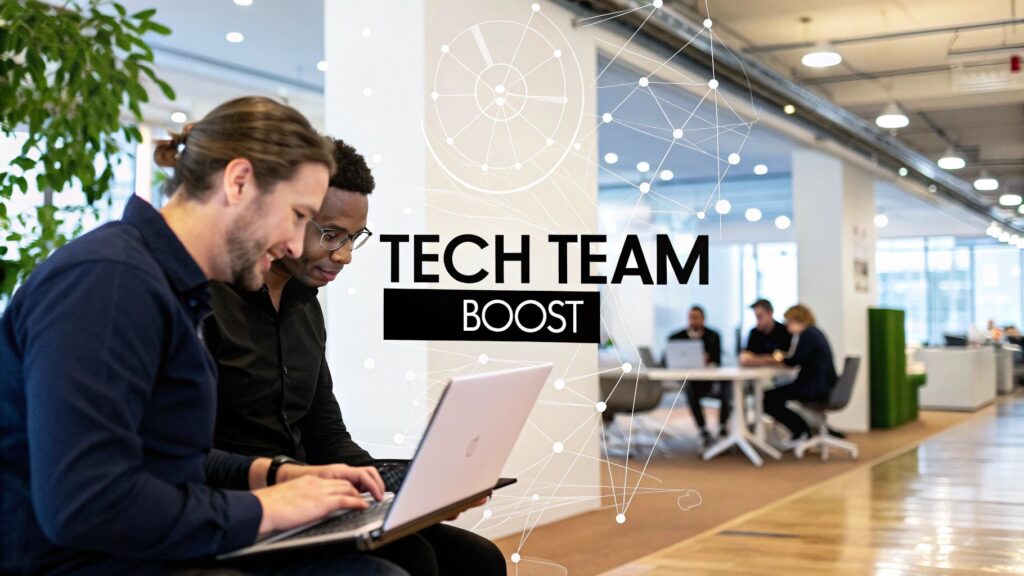Elevate Your Tech Team: Unlocking the Power of IT Staff Augmentation
Need to scale your tech team quickly and efficiently? This listicle explores the key benefits of IT staff augmentation, helping you understand how it can empower your organization for growth. Discover how leveraging IT staff augmentation provides cost efficiency, access to specialized talent, enhanced scalability, faster time-to-market, reduced risk, and knowledge transfer. Learn how these advantages translate to a stronger competitive edge by optimizing your tech workforce and projects.
1. Cost Efficiency
One of the most compelling benefits of IT staff augmentation is its potential for significant cost savings. This approach allows companies to strategically fill talent gaps by hiring skilled professionals on a temporary basis, rather than committing to the long-term expenses associated with full-time employees. Essentially, you’re paying only for the specific skills and expertise you need, precisely when you need them. This eliminates the overhead costs associated with salaries, benefits, insurance, paid time off, training, office space, and equipment for permanent staff.

This pay-as-you-go model offers several key features that contribute to its cost-effectiveness: no long-term financial commitments, elimination of onboarding and training costs, reduced overhead expenses, and no recruitment or termination costs. This makes it an attractive alternative to both traditional hiring and outsourcing entire projects, especially for growing companies in the technology sector with 11-200 employees. For C-level executives making strategic decisions, demonstrating cost efficiency is crucial, and IT staff augmentation delivers on this front.
Features and Benefits:
- Pay-for-what-you-use model: You only pay for the specific skills and time required, optimizing your budget allocation.
- No long-term financial commitments: Avoid the burden of salaries and benefits associated with permanent employees, providing flexibility and scalability.
- Elimination of onboarding and training costs: Augmented staff typically come ready to contribute with minimal onboarding required, saving both time and money.
- Reduced overhead expenses: Reduce costs associated with office space, equipment, and other overhead expenses.
- No recruitment or termination costs: Streamline your workforce management by avoiding the expenses associated with recruiting, hiring, and terminating employees.
Pros:
- 30-40% average cost savings compared to traditional hiring: Realize substantial savings by leveraging the cost advantages of staff augmentation.
- No benefits or insurance payments required: Eliminate the financial burden of providing employee benefits and insurance.
- Avoid costs of idle time between projects: Optimize resource utilization and avoid paying for unproductive time.
- Predictable budget planning with fixed-rate contracts: Gain better control over project budgets with predictable and transparent pricing.
- Tax advantages in many jurisdictions: Explore potential tax benefits associated with staff augmentation contracts.
Cons:
- Premium rates for highly specialized skills: Highly sought-after skills may command premium rates, potentially impacting cost savings.
- Potential hidden costs in some contracts: Carefully review contracts to avoid unforeseen expenses.
- May cost more than outsourcing to offshore teams: While offering advantages in communication and collaboration, staff augmentation may be more expensive than some offshore outsourcing options.
Real-World Examples:
- IBM reduced operational costs by 25% through strategic staff augmentation.
- Deloitte saved approximately $1.2M annually by augmenting their development team instead of hiring full-time specialists.
- American Express implemented staff augmentation for their digital transformation, reducing project costs by 35%.
Actionable Tips for C-Level Executives:
- Negotiate rate caps for long-term engagements: Secure favorable rates for extended projects.
- Consider blended pricing models for teams with varying skill levels: Optimize costs by tailoring pricing to the specific skill sets required.
- Compare TCO (total cost of ownership) between staff augmentation and traditional hiring: Conduct a thorough cost analysis to determine the most cost-effective approach.
- Request transparent pricing models from augmentation providers: Ensure clear and upfront pricing to avoid unexpected costs.
Cost efficiency deserves its top spot on the list of benefits of IT staff augmentation because it directly impacts the bottom line. For growing companies and those navigating rapidly changing technology landscapes, the ability to access specialized skills without the financial burden of permanent hires is a significant advantage. This flexibility allows businesses to remain competitive, scale quickly, and adapt to market demands while optimizing their resources.
2. Access to Specialized Talent
One of the most compelling benefits of IT staff augmentation is the rapid access it provides to highly specialized technical talent. In today’s fast-paced technological landscape, finding and recruiting individuals with niche skills like AI development, blockchain expertise, or advanced cybersecurity can be a lengthy and expensive process. IT staff augmentation offers a solution by allowing organizations to tap into a global talent pool of pre-vetted professionals, bypassing the traditional hiring process and gaining immediate access to the expertise they need. This is particularly advantageous for projects with tight deadlines or those requiring cutting-edge technological skills that may not be readily available within the existing team.

This approach offers several key features that make it highly attractive for businesses, particularly those in the technology sector or those experiencing rapid growth. Accessing a global talent marketplace expands your potential candidate pool exponentially, allowing you to pinpoint specialists with niche technical skills and proven experience. This means you can quickly scale specialized teams as needed, ensuring your projects have the precise expertise required at every stage. Moreover, leveraging augmented staff provides access to cutting-edge technological expertise, allowing your company to stay competitive and innovate effectively.
Consider the example of Microsoft, which regularly augments its teams with AI specialists for specific product development cycles. Similarly, JP Morgan Chase leveraged blockchain experts through staff augmentation to develop their cryptocurrency platform, and Netflix has used specialized data scientists through augmentation to enhance their recommendation algorithms. These examples highlight how leading companies utilize staff augmentation to access specialized talent and drive innovation.
Pros of Accessing Specialized Talent through Augmentation:
- Immediate Infusion of Specialized Knowledge: Get the expertise you need, when you need it, without lengthy onboarding or training.
- No Long-Term Training Investments: Avoid the costs and time associated with upskilling existing staff.
- Access to Expertise in Emerging Technologies: Stay ahead of the curve by tapping into experts in rapidly evolving fields.
- Higher Quality Deliverables Through Expert Input: Improve the quality of your projects with specialized knowledge and experience.
- Exposure to Diverse Technological Approaches: Gain insights from professionals with varied backgrounds and perspectives.
Cons of Accessing Specialized Talent through Augmentation:
- Competition for Top-Tier Talent: Highly sought-after specialists can be in high demand.
- Potential Knowledge Gaps About Company Processes: External resources may require time to integrate into existing workflows.
- Possibility of Cultural or Communication Barriers: Working with a global talent pool can present communication challenges.
- Risk of Dependency on Specialized External Resources: Over-reliance on augmented staff can create potential vulnerabilities.
Tips for Effective Staff Augmentation:
- Clearly Define the Specialized Skills Required: Create a detailed list of necessary skills and experience before starting your search.
- Consider Creating Skill Matrices: Identify exact expertise needed and map it against potential candidates.
- Request Portfolios and Case Studies of Similar Work: Evaluate candidates’ previous work to ensure they have the required capabilities.
- Implement Knowledge Transfer Protocols: Facilitate knowledge sharing between augmented staff and internal teams.
- Use Technical Assessments to Verify Specialized Capabilities: Ensure candidates possess the claimed expertise.
For growing companies with 11-200 employees, particularly in the technology sector, leveraging specialized talent through IT staff augmentation can be a strategic advantage. It allows you to quickly access the skills you need to drive innovation, meet project deadlines, and remain competitive in a dynamic market. By carefully defining your requirements, implementing robust selection processes, and fostering effective communication, you can maximize the benefits of IT staff augmentation and achieve your business objectives. This approach empowers C-level executives to make strategic decisions that optimize resource allocation and drive growth.
3. Enhanced Scalability and Flexibility
One of the most significant benefits of IT staff augmentation is the enhanced scalability and flexibility it offers. In today’s dynamic business environment, companies must be able to adapt quickly to changing market conditions, project requirements, and customer demands. IT staff augmentation enables organizations to scale their technical teams up or down rapidly in response to these fluctuating needs. This agility allows for efficient resource allocation and optimized project delivery without the rigid constraints of traditional hiring processes or the long-term commitment of permanent headcount increases. This creates a highly adaptable workforce that aligns perfectly with evolving business cycles and strategic objectives. For growing businesses, particularly those in the technology sector or those embracing remote work models, this adaptability is paramount.

This approach provides several key features, including on-demand resource scaling, quick team expansion and contraction, project-based staffing adjustments, adaptable team composition, and rapid deployment capabilities. These features empower organizations to respond proactively to emerging opportunities and challenges. For example, imagine a sudden surge in demand for a new product feature. With IT staff augmentation, a company can quickly onboard specialized developers to accelerate development and capitalize on the market opportunity. Conversely, if a project is temporarily put on hold, the augmented staff can be scaled down, preventing unnecessary overhead costs.
The pros of leveraging IT staff augmentation for scalability are numerous, including the ability to respond quickly to market opportunities, support for seasonal business fluctuations, risk mitigation during uncertain business periods, faster project implementation timelines, and adaptability to changing technical requirements. These advantages are particularly relevant for C-level executives making strategic decisions for organizations with 11-200 employees, where agility and cost-effectiveness are critical drivers of success.
However, it’s important to be aware of the potential downsides. Possible continuity challenges can arise with frequent scaling, requiring diligent knowledge management. Administrative overhead in managing variable team sizes should also be considered. Finally, the changing composition of the team can sometimes impact team cohesion, requiring proactive team-building efforts.
Real-world examples demonstrate the power of IT staff augmentation for achieving scalability. Amazon famously scales up its development teams by 40% during peak season preparation using augmentation. Salesforce routinely adjusts their implementation teams through augmentation based on client project sizes. Uber rapidly scaled their engineering team through augmentation during international expansion phases. These examples underscore the effectiveness of this approach for companies of all sizes.
To maximize the benefits of IT staff augmentation for scalability, consider these actionable tips: develop clear onboarding processes for quick integration of new team members; maintain a bench of pre-vetted resources for rapid scaling; create standardized documentation to facilitate knowledge transfer; implement team size forecasting based on business projections; and use contract options that allow for easy scaling clauses. These practices will streamline the process and ensure a smooth transition when scaling your team.
Learn more about Enhanced Scalability and Flexibility to further understand how this strategy can benefit your organization. By embracing this approach, businesses can gain a competitive edge in today’s rapidly changing marketplace. This specific benefit of IT staff augmentation deserves its place on the list because it directly addresses the critical need for agility and responsiveness in today’s competitive business landscape, offering a powerful solution for organizations seeking to optimize their workforce and achieve sustainable growth.
4. Reduced Time-to-Market
In today’s fast-paced technological landscape, speed is often the key to success. One of the most compelling benefits of IT staff augmentation is its ability to significantly reduce time-to-market for new products and services. This advantage stems from the elimination of lengthy recruitment processes, allowing organizations to swiftly deploy pre-qualified technical resources. Instead of spending weeks or even months searching for, interviewing, and onboarding new employees, companies can leverage staff augmentation to inject ready-to-work professionals directly into their projects. This accelerates project timelines, enabling businesses to capitalize on market opportunities before competitors and establish a strong foothold in their respective industries. By quickly assembling highly skilled teams, organizations can respond rapidly to evolving market demands and maintain a competitive edge.

IT staff augmentation offers several features contributing to faster time-to-market: immediate project initiation capabilities, elimination of recruitment delays, rapid team formation, a pool of ready-to-deploy skilled professionals, and the ability to implement parallel development. These features translate into tangible benefits, including a competitive advantage through faster deployment, earlier revenue generation, reduced opportunity costs from delays, better responsiveness to market trends, and the ability to meet tight deadlines and critical launch windows.
Real-world examples showcase the power of this approach. Spotify reduced feature development time by 35% using augmented engineering teams, enabling them to rapidly iterate and deliver new functionalities to their users. Capital One launched their new mobile banking platform three months ahead of schedule by leveraging staff augmentation, gaining a significant first-mover advantage. Similarly, Adobe accelerated their Creative Cloud updates through strategic staff augmentation, ensuring they remained at the forefront of the creative software market.
While the benefits are substantial, it’s crucial to acknowledge potential drawbacks. There might be an initial ramp-up time as augmented staff members integrate into the project and understand its context. If not managed carefully, a rapid deployment could lead to rushed delivery and inadequate integration, potentially impacting quality. Therefore, a balanced approach is essential.
To maximize the benefits and mitigate potential risks, consider these actionable tips:
- Create comprehensive project briefs: Provide augmented staff with detailed information about the project’s goals, scope, and existing infrastructure to accelerate onboarding.
- Implement CI/CD pipelines: Continuous integration and continuous delivery pipelines support rapid development and deployment, further accelerating time-to-market.
- Use collaborative tools: Facilitate seamless communication and knowledge sharing within the augmented team using project management platforms and communication tools.
- Conduct sprint zero for alignment: Before full-speed development, dedicate a sprint to align the team, establish shared understanding, and clarify expectations.
- Establish clear milestones: Track accelerated progress effectively by setting clear, measurable milestones.
The growing popularity of agile methodologies, championed by organizations like the Agile Alliance, emphasizes flexible resourcing, further solidifying the value of IT staff augmentation. Consulting giants like Deloitte Digital also leverage this approach for accelerated delivery, showcasing its effectiveness in large-scale projects. The rise of DevOps practices, with its emphasis on automation and collaboration, also inherently supports augmented teams.
For growing companies in the technology sector, particularly those with 11-200 employees making strategic decisions, IT staff augmentation offers a powerful tool to navigate the competitive landscape. By strategically integrating skilled professionals, organizations can significantly reduce their time-to-market, seize valuable market opportunities, and drive rapid growth. This benefit alone justifies its inclusion in the list of advantages offered by IT staff augmentation, making it a compelling strategy for C-level executives seeking to enhance their organization’s agility and competitiveness.
5. Risk Mitigation and Reduced Commitment
One of the most compelling benefits of IT staff augmentation is its ability to mitigate risk and reduce long-term commitments, making it a valuable strategy for businesses of all sizes, particularly those in the technology sector with 11-200 employees experiencing rapid growth. For C-level executives making strategic decisions, understanding this advantage is crucial. Instead of undertaking the often lengthy and complex process of permanent hiring, IT staff augmentation allows organizations to access specialized tech talent on a contract basis. This approach offers a powerful safety net, particularly in today’s dynamic and often unpredictable market. This flexibility is invaluable for growing companies navigating evolving project needs and uncertain economic conditions.
How it Works: Staff augmentation allows you to bring in external experts to fill specific skill gaps within your existing team. These individuals work alongside your permanent employees, integrating seamlessly into your projects. The key difference is their contractual status: they are not permanent hires, which offers significant advantages in terms of commitment and financial flexibility. You can evaluate their performance and cultural fit before making any long-term decisions. This “trial-before-hire” capability is a significant benefit, allowing you to ensure the augmented staff are the right fit for your organization.
Features that Facilitate Risk Mitigation:
- Trial-before-hire capabilities: Evaluate performance and fit before committing to permanent employment.
- Contractual flexibility: Adjust team size and skillsets as project needs evolve.
- Distributed risk model: Share project risks between internal and external resources.
- No termination complications: Easier and less costly disengagement if project requirements change or performance isn’t satisfactory.
- Project-based engagement structures: Align resource allocation precisely with project timelines and budgets.
Pros:
- Reduced financial risk during economic uncertainty: Avoid the fixed costs associated with permanent hires during volatile market conditions.
- Easy disengagement if project requirements change: Adapt quickly to evolving project needs without the complexities of layoffs.
- Protection against skill obsolescence: Access cutting-edge skills and expertise without the burden of continuous internal training.
- Lower exposure to employment liabilities: Reduce exposure to costs related to benefits, payroll taxes, and unemployment insurance.
- Ability to pivot technology direction with minimal disruption: Quickly integrate new technologies and expertise without long-term commitments.
Cons:
- Potential higher turnover than permanent staff: Contract employees may be more likely to move on to other opportunities.
- Intellectual property protection challenges: Requires careful management of confidential information and robust IP protection agreements.
- Possible continuity risks between projects: Requires proactive knowledge transfer processes to maintain project momentum.
Examples of Successful Implementation:
- GE: Utilized staff augmentation during their digital transformation to mitigate the risks associated with a large-scale hiring initiative, allowing them to scale their teams rapidly and efficiently.
- Bank of America: Leveraged contract-to-hire models during periods of regulatory uncertainty, maintaining flexibility while accessing necessary expertise.
- Target: Implemented staff augmentation following a data breach to quickly address security vulnerabilities without making long-term commitments, allowing them to rapidly bolster their security posture.
Actionable Tips:
- Implement appropriate NDAs and IP protection clauses: Safeguard sensitive information and intellectual property.
- Develop staged engagement models with performance gates: Evaluate performance at regular intervals and make informed decisions about continuing the engagement.
- Create knowledge transfer protocols to reduce dependency risks: Ensure smooth transitions between projects and maintain business continuity.
- Use augmentation as a validation period before permanent hiring: Test the waters before committing to a permanent position.
- Maintain relationships with reliable augmentation partners for future needs: Build a network of trusted partners to streamline future staffing needs.
Why This Deserves Its Place on the List: In a rapidly changing business environment, agility and risk management are paramount. IT staff augmentation offers a crucial advantage by providing access to specialized skills and resources without the long-term commitments and financial burdens of permanent hiring. This allows companies, particularly those in high-growth phases, to remain competitive, adapt to market fluctuations, and seize opportunities as they arise. This benefit is heavily endorsed by leading authorities such as PwC, Harvard Business Review, and Robert Half, who advocate for flexible and strategic staffing approaches. By understanding and leveraging the risk mitigation benefits of staff augmentation, businesses can position themselves for sustainable growth and success.
6. Knowledge Transfer and Innovation Infusion
One of the most compelling benefits of IT staff augmentation is its ability to act as a catalyst for knowledge transfer and innovation infusion. By strategically integrating external specialists into your existing teams, you inject fresh perspectives, innovative approaches, and diverse experiences, creating a powerful ecosystem for knowledge sharing and technological advancement. This is especially crucial for organizations with 11-200 employees in the technology sector (or those embracing remote work) that are actively investing in growth, as it provides a rapid and efficient way to acquire critical skills and stay ahead of the curve. For C-level decision-makers charting the strategic direction of their companies, this aspect of IT staff augmentation offers a compelling argument for its adoption.
This cross-pollination of ideas and methodologies exposes your internal team to a wider range of technological approaches, best practices from across industries, and ultimately enhances their skillsets. Augmented staff act as innovation catalysts, bringing external expertise that can help break through technical stagnation and accelerate the development of cutting-edge solutions. Think of it as a concentrated dose of industry best practices and emerging technologies injected directly into your team.
Features of Knowledge Transfer and Innovation Infusion:
- Cross-pollination of ideas and methodologies
- Exposure to diverse technological approaches
- Best practice sharing across industries
- Skill development for permanent staff
- Innovation catalysts through external expertise
Pros:
- Accelerated organizational learning
- Prevention of technical stagnation
- Competitive advantage through knowledge diversification
- Internal capability enhancement through exposure
- Creation of innovation ecosystems
Cons:
- Potential intellectual property considerations (which should be addressed through robust contracts)
- Risk of knowledge loss if not properly documented (mitigated through dedicated knowledge transfer processes)
- Cultural resistance to external ideas (addressed through careful team integration and change management)
Examples of Successful Implementation:
- Google’s Project Aristotle demonstrated the power of augmented teams to introduce and disseminate best practices, like psychological safety, within engineering teams.
- Cisco accelerated their DevSecOps transformation by augmenting their teams with security specialists who transferred critical knowledge and skills.
- Tesla leveraged the expertise of augmented engineering specialists to accelerate innovation and improvement in their battery technology.
Actionable Tips for Effective Knowledge Transfer:
- Pair Programming and Shadowing: Implement pair programming or shadowing between augmented and permanent staff to facilitate direct knowledge sharing.
- Formal Knowledge Transfer Sessions: Create structured knowledge transfer sessions and documentation requirements to ensure valuable insights are captured and preserved.
- Communities of Practice: Develop communities of practice that include both internal and augmented staff to foster ongoing collaboration and knowledge exchange.
- Innovation Workshops: Organize innovation workshops led by augmented specialists to introduce new ideas and inspire creative problem-solving.
- Retrospectives: Use retrospectives to capture lessons learned, document new knowledge, and institutionalize best practices.
This approach is particularly valuable when facing rapid technological change, needing specialized expertise for a specific project, or aiming to inject new energy and innovation into your existing teams. By fostering a culture of learning and knowledge sharing, you can maximize the benefits of IT staff augmentation and create a truly innovative and competitive organization. Learn more about Knowledge Transfer and Innovation Infusion for further insights into the practical aspects of integrating augmented teams.
The importance of knowledge transfer and innovation infusion within the context of IT staff augmentation is underscored by research from prominent institutions such as MIT (on innovation through knowledge diversity), ThoughtWorks (emphasis on cross-pollination in technical teams), and IDC (studies correlating team diversity and innovation). This benefit of IT staff augmentation deserves its place on this list because it directly contributes to long-term organizational growth and competitive advantage, aligning perfectly with the strategic objectives of C-level decision-makers.
6 Benefits Comparison of IT Staff Augmentation
| Benefit | Implementation Complexity 🔄 | Resource Requirements 💡 | Expected Outcomes 📊 | Ideal Use Cases 💡 | Key Advantages ⭐⚡ |
|---|---|---|---|---|---|
| Cost Efficiency | Low – straightforward with clear budget controls | Moderate – depends on contract negotiation | Significant cost savings (30-40%) | Organizations aiming to reduce operational costs | Pay-for-use model, no long-term commitments, predictable budgeting ⚡⭐ |
| Access to Specialized Talent | Moderate – requires precise skill matching | High – sourcing and vetting niche experts | Immediate access to expert knowledge and quality deliverables | Projects needing niche technical skills or emerging tech | Global talent access, fast expertise infusion, higher quality output ⭐ |
| Enhanced Scalability and Flexibility | Moderate – needs scalable onboarding and management | Variable – depending on scaling frequency | Rapid team size adjustments, better agility | Seasonal projects, fluctuating workloads | Quick scaling up/down, adapts to business cycles, risk mitigation ⚡ |
| Reduced Time-to-Market | Low to Moderate – fast deployment but requires onboarding | Moderate – depends on ready-to-deploy skills | Faster project start and completion, earlier revenue realization | Time-critical projects, competitive markets | Elimination of recruitment delays, accelerated delivery, faster ROI ⭐⚡ |
| Risk Mitigation and Reduced Commitment | Low – contract-based with flexible terms | Moderate – needs legal and performance management | Lower financial and operational risks | Uncertain markets or projects requiring evaluation periods | Trial-before-hire, easy disengagement, lowered liabilities ⭐ |
| Knowledge Transfer and Innovation Infusion | Moderate – requires collaboration and documentation | High – continuous interaction between teams | Enhanced organizational learning and innovation | Organizations seeking sustained capability enhancement | Cross-pollination of ideas, competitive advantage, fosters innovation ⭐ |
Supercharge Your Team with Nearshore Business Solutions
In today’s dynamic tech landscape, leveraging the benefits of IT staff augmentation is no longer a luxury, but a necessity for staying competitive. We’ve explored how augmenting your team can lead to significant cost efficiencies, provide access to specialized talent pools, enhance your scalability and flexibility, reduce time-to-market for crucial projects, mitigate risk, and even infuse your internal teams with fresh innovation. Mastering these approaches is crucial for C-level executives making strategic decisions, as it directly impacts a company’s bottom line, growth trajectory, and ability to adapt to market changes. For businesses seeking to augment their IT teams with nearshore talent, exploring options like those offered by PlusClouds can provide numerous advantages in terms of cost-effectiveness, access to skilled professionals, and streamlined collaboration. You can learn more about their services on their blog: Nearshore Business Solutions. By strategically integrating external expertise, you can optimize your internal resources, focusing on core business objectives while ensuring your tech capabilities remain cutting-edge.
The benefits of IT staff augmentation empower businesses, especially those in the 11-200 employee range experiencing rapid growth, to navigate the complexities of the modern tech world with agility and confidence. Unlock your company’s full potential and gain a competitive edge. Ready to explore how Nearshore Business Solutions can connect you with top-tier talent and transform your tech capabilities? Contact us today to discuss your specific needs and discover the perfect augmentation strategy for your business.

